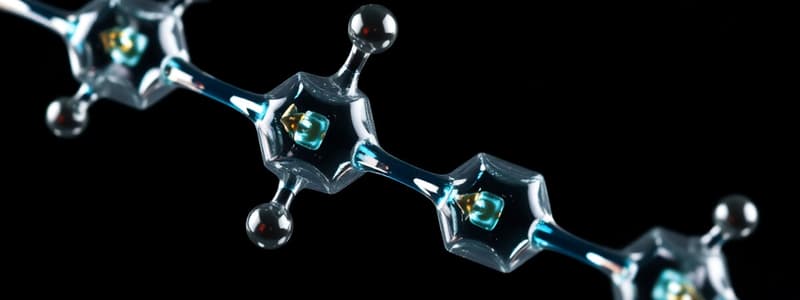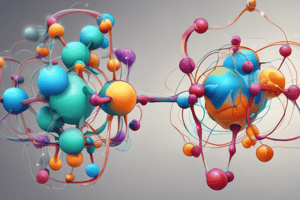Podcast
Questions and Answers
Which type of bond involves the equal sharing of electrons between atoms?
Which type of bond involves the equal sharing of electrons between atoms?
- Nonpolar covalent bonds (correct)
- Ionic bonds
- Polar covalent bonds
- Hydrogen bonds
What characterizes non-covalent interactions compared to covalent bonds?
What characterizes non-covalent interactions compared to covalent bonds?
- They require high energy to form.
- They involve complete electron transfer.
- They are weaker and more transient. (correct)
- They are much stronger.
What occurs during a condensation reaction?
What occurs during a condensation reaction?
- Monomers combine and water is released. (correct)
- Water is added to split molecules.
- Polymers dissolve in water.
- Ionic bonds are formed between molecules.
Which interaction is specifically characterized by the attraction between oppositely charged ions?
Which interaction is specifically characterized by the attraction between oppositely charged ions?
What type of macromolecule is composed of amino acids linked by peptide bonds?
What type of macromolecule is composed of amino acids linked by peptide bonds?
What term refers to the measure of the strength of binding between interacting molecules?
What term refers to the measure of the strength of binding between interacting molecules?
Hydrophobic interactions are primarily responsible for which of the following?
Hydrophobic interactions are primarily responsible for which of the following?
Which statement correctly describes the role of non-covalent bonds in biological processes?
Which statement correctly describes the role of non-covalent bonds in biological processes?
What is the condition when the rate of the forward reaction equals the rate of the reverse reaction?
What is the condition when the rate of the forward reaction equals the rate of the reverse reaction?
Which of the following correctly describes a buffer's function?
Which of the following correctly describes a buffer's function?
What is the primary role of ATP in cellular processes?
What is the primary role of ATP in cellular processes?
What defines the pH scale?
What defines the pH scale?
What is the consequence of reactions being in a steady state within cells?
What is the consequence of reactions being in a steady state within cells?
Which type of energy is associated with the motion of molecules within a system?
Which type of energy is associated with the motion of molecules within a system?
Which of the following correctly describes redox reactions?
Which of the following correctly describes redox reactions?
What is the flow of genetic information in a cell?
What is the flow of genetic information in a cell?
Flashcards
Covalent Bond
Covalent Bond
A strong bond where atoms share electrons.
Nonpolar Covalent Bond
Nonpolar Covalent Bond
Equal sharing of electrons.
Polar Covalent Bond
Polar Covalent Bond
Unequal sharing, creating charges.
Non-Covalent Interaction
Non-Covalent Interaction
Signup and view all the flashcards
Molecular Complementarity
Molecular Complementarity
Signup and view all the flashcards
Macromolecules
Macromolecules
Signup and view all the flashcards
Condensation Reaction
Condensation Reaction
Signup and view all the flashcards
Hydrolysis
Hydrolysis
Signup and view all the flashcards
Chemical Equilibrium
Chemical Equilibrium
Signup and view all the flashcards
Steady State
Steady State
Signup and view all the flashcards
Homeostasis
Homeostasis
Signup and view all the flashcards
pH
pH
Signup and view all the flashcards
Free Energy (ΔG)
Free Energy (ΔG)
Signup and view all the flashcards
Exergonic Reaction
Exergonic Reaction
Signup and view all the flashcards
ATP
ATP
Signup and view all the flashcards
Central Dogma
Central Dogma
Signup and view all the flashcards
Study Notes
Chemical Foundation
- Covalent Bonds: Stable bonds formed when atoms share electrons.
- Nonpolar Covalent Bonds: Equal sharing of electrons; examples include hydrocarbons and hydrophobic molecules.
- Polar Covalent Bonds: Unequal sharing of electrons, creating partial positive and negative charges (dipoles); found in water.
- Non-Covalent Interactions: Weaker than covalent bonds, crucial for transient biological interactions.
- Ionic Bonds: Attraction between oppositely charged ions (e.g., Na+ and Cl-); involve complete electron transfer.
- Hydrogen Bonds: Weak bonds involving a partially positive hydrogen atom and an unpaired electron pair (commonly with O or N); found in water molecules.
- Van der Waals Forces: Weak, non-specific attractions between atoms that are close together; important for molecular packing and shape interactions.
- Hydrophobic Interactions: Nonpolar molecules cluster together in water to minimize energy (e.g., lipid bilayers).
Molecular Complementarity
- Definition: Molecules interact based on complementary shapes, charges, and properties.
- Parameters: Specificity (precision of fit between molecules) and affinity (strength of binding, measured by Kd).
- Examples: Receptor-ligand binding, antibody-antigen interactions.
- Proteins: Proteins can have multiple binding sites for different ligands (molecules).
- Covalent Bonds & Flexibility: Covalent bonds are strong and stable, but transient non-covalent bonds allow flexibility.
Chemical Building Blocks
- Macromolecules: Constructed from monomers via condensation reactions (removal of water).
- Protein Types: Composed of amino acids linked by peptide bonds.
- Nucleic Acid Types: Made of nucleotides linked by phosphodiester bonds.
- Carbohydrate Types: Built from monosaccharides linked by glycosidic bonds.
- Lipid Types: Non-polymeric, composed of hydrophobic tails (often fatty acids) and hydrophilic heads.
- Condensation Reaction: Combines monomers by removing water.
- Hydrolysis: Breaks down macromolecules by adding water.
Chemical Reactions and Equilibrium
- Chemical Equilibrium: Occurs when the rate of the forward reaction equals the rate of the reverse reaction.
- Equilibrium Constant (Keq): Reflects the ratio of products to reactants.
- Steady State vs. Equilibrium: In cells, reactions are in a steady state (intermediate formation and consumption at the same rate) rather than true equilibrium.
- Homeostasis: The steady state maintains stable conditions within cells.
pH and Buffers
- pH Scale: Measures the negative logarithm of hydrogen ion concentration.
- Cytoplasmic pH: Approximately 7.2-7.4 (neutral).
- Lysosomal pH: Approximately 4.5 (acidic).
- Acids and Bases: Acids release H+ ions; bases bind H+ ions.
- Buffers: Mixtures of weak acids and their conjugate bases that minimize pH changes.
Biochemical Energetics
- Energy Types: Kinetic energy (energy of motion), potential energy (stored energy).
- Concentration Gradients: Energy stored due to unequal distribution of molecules.
- Electric Potential: Energy from charge separation across a membrane.
- Free Energy (ΔG): Measure of energy available for a reaction; spontaneous reactions have negative ΔG.
- Chemical Coupling: Thermodynamically unfavorable reactions are driven by coupling with exergonic (energy-releasing) reactions.
- ATP: Universal energy currency in cells; energy stored in phosphoanhydride bonds, which release energy upon hydrolysis.
- Redox Reactions: Oxidation (loss of electrons) and reduction (gain of electrons) involve electron carriers (e.g., NAD+, NADP+, FAD).
Central Dogma
- Flow of Genetic Information: DNA → RNA → Protein. This flow controls cellular function and gene expression.
Studying That Suits You
Use AI to generate personalized quizzes and flashcards to suit your learning preferences.




